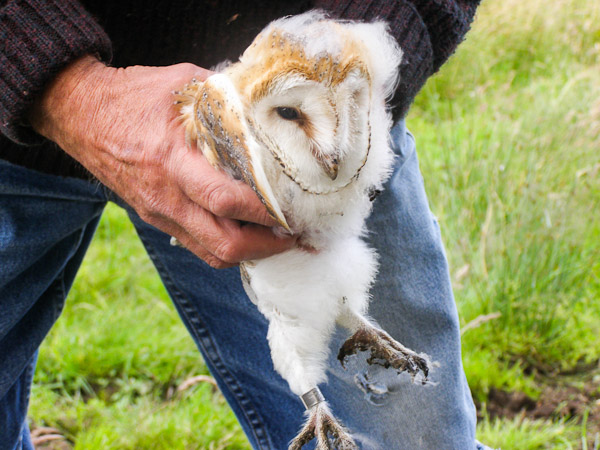Barn Owls on Mull often become active just after dusk and the sight of a ghostly pale Barn Owl hunting for voles on the road verges and through the tussock grass is a sight to behold. Like most owls the Barn Owl flies silently, tiny serrations on the leading edges of its flight feathers help to break up the flow of air over its wings, thereby reducing turbulence and the noise that accompanies it.

The Barn Owl has acute hearing, with ears placed asymmetrically for improved detection of sound position and distance, and it does not require sight to hunt. Hunting nocturnally it can target and dive down, penetrating its talons through snow, grass or brush to seize rodents with deadly accuracy. Compared to other owls of similar size, the Barn Owl has a much higher metabolic rate, requiring relatively more food. Pound for pound, Barn Owls consume more rodents – often regarded as pests by humans – than possibly any other creature. This makes the Barn Owls on Mull one of the most economically valuable wildlife animals to farmers. Farmers often encourage Barn Owl habitation by providing nest sites.
We have two Barn Owl boxes here at High Oatfield prompted by a spectacular display from two Barn Owls shortly after we finished building the house. The Owls were attracted by the bats that in turn were trying to catch moths drawn to the outside light one winters evening. We sat in our living room with Barn Owls flying past the window just feet away watching them try to catch the bats.
In 2008 the pair that had taken up residence in our first box raised six chicks, a large brood and an indication that it was also a good year for the vole population too. We put a second box up to give the new Owls a roost and hoped they would breed. The Owlets were ringed and recorded and later in the year we found a Barn Owl body, mostly devoured, on the hill where the Sea Eagles often sit. From its identification ring we could tell it was one of the young Barn Owls from our box.
Sadly in 2009 the pair in the original box failed to hatch their eggs as the weather was so poor in the early spring and the vole population was insufficient to feed the chicks.
2010 saw our resident Barn Owls raise three chicks, this time in the second Barn Owl box to the rear of the garden. The call of the young Owlets waiting for their parents to return with food was a very strange sound, heavy breathing from the garden late at night was very disconcerting until we discovered its source. As the Owlets got older the noise became more of a screech.
Due to horrendous weather in early May in both 2011 and 2012, with gale force winds for a week or so the Barn Owls didn’t raise chicks but continued to use the boxes for roosting.
We are hoping that 2013 sees the Barn Owls on Mull having a better and more successful breeding year.
2013 update
We are very pleased to say that both our Barn owl boxes are in use, we have a female sitting on eggs in one box and a male using the other as a roost. We are just about to put a third box up on our garage gable end to try to encourage more of these beautiful birds.
